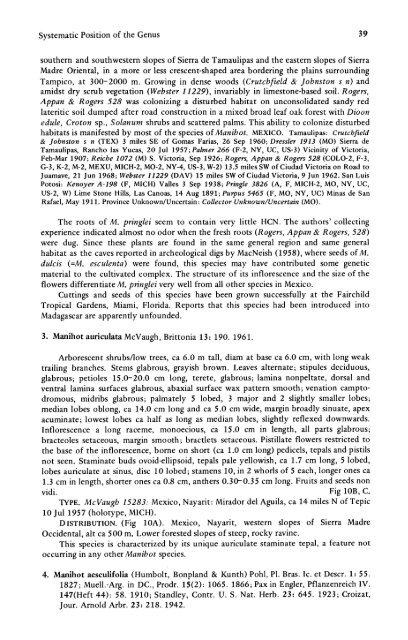Manihot Manihotoides (Euphorbiaceae) - CNCFlora
Manihot Manihotoides (Euphorbiaceae) - CNCFlora
Manihot Manihotoides (Euphorbiaceae) - CNCFlora
You also want an ePaper? Increase the reach of your titles
YUMPU automatically turns print PDFs into web optimized ePapers that Google loves.
Systematic Position of the Genus 39<br />
southern and southwestern slopes of Sierra de Tamaulipas and the eastern slopes of Sierra<br />
Madre Oriental, in a more or less crescent-shaped area bordering the plains surrounding<br />
Tampico, at 300-2000 m. Growing in dense woods (Crutchfield & Johnston s n) and<br />
amidst dry scrub vegetation (Webster 11229), invariably in limestone-based soil. Rogers,<br />
Appan & Rogers 528 was colonizing a disturbed habitat on unconsolidated sandy red<br />
lateritic soil dumped after road construction in a mixed broad leaf oak forest with Dioon<br />
edule, Croton sp., Solanum shrubs and scattered palms. This ability to colonize disturbed<br />
habitats is manifested by most of the species of <strong>Manihot</strong>. MEXICO. Tamaulipas: Crutchfield<br />
& Johnston s n (TEX) 3 miles SE of Gomas Farias, 26 Sep 1960; Dressier 1913 (MO) Sierra de<br />
Tamaulipas, Rancho las Yucas, 20 Jul 1957; Palmer 266 (F-2, NY, UC, US-3) Vicinity of Victoria,<br />
Feb-Mar 1907; Reiche 1072 (M) S. Victoria, Sep 1926; Rogers, Appan & Rogers 528 (COLO-2, F-3,<br />
G-3, K-2, M-2, MEXU, MICH-2, MO-2, NY-4, US-3, W-2) 13.5 miles SW of Ciudad Victoria on Road to<br />
Juamave, 21 Jun 1968; Webster 11229 (DAV) 15 miles SW of Ciudad Victoria, 9 Jun 1962. San Luis<br />
Potosi: Kenoyer A-198 (F, MICH) Valles 3 Sep 1938; Pringle 3826 (A, F, MICH-2, MO, NY, UC,<br />
US-2, W) Lime Stone Hills, Las Canoas, 14 Aug 1891; Purpus 5465 (F, MO, NY, UC) Minas de San<br />
Rafael, May 1911. Province Unknown/Uncertain: Collector Unknown/Uncertain (MO).<br />
The roots of M. pringlei seem to contain very little HCN. The authors' collecting<br />
experience indicated almost no odor when the fresh roots (Rogers, Appan & Rogers, 528)<br />
were dug. Since these plants are found in the same general region and same general<br />
habitat as the caves reported in archeological digs by MacNeish (1958), where seeds of M.<br />
dulcis (=M. esculenta) were found, this species may have contributed some genetic<br />
material to the cultivated complex. The structure of its inflorescence and the size of the<br />
flowers differentiate M. pringlei very well from all other species in Mexico.<br />
Cuttings and seeds of this species have been grown successfully<br />
at the Fairchild<br />
Tropical Gardens, Miami, Florida. Reports that this species had been introduced into<br />
Madagascar are apparently unfounded.<br />
3. <strong>Manihot</strong> auriculata McVaugh, Brittonia 13: 190. 1961.<br />
Arborescent shrubs/low trees, ca 6.0 m tall, diam at base ca 6.0 cm, with long weak<br />
trailing branches. Stems glabrous, grayish brown. Leaves alternate; stipules deciduous,<br />
glabrous; petioles 15.0-20.0 cm long, terete, glabrous; lamina nonpeltate, dorsal and<br />
ventral lamina surfaces glabrous, abaxial surface wax pattern smooth; venation camptodromous,<br />
midribs glabrous; palmately 5 lobed, 3 major and 2 slightly smaller lobes;<br />
median lobes oblong, ca 14.0 cm long and ca 5.0 cm wide, margin broadly sinuate, apex<br />
acuminate; lowest lobes ca half as long as median lobes, slightly reflexed downwards.<br />
Inflorescence a long raceme, monoecious, ca 15.0 cm in length, all parts glabrous;<br />
bracteoles setaceous, margin smooth; bractlets setaceous. Pistillate flowers restricted to<br />
the base of the inflorescence, borne on short (ca 1.0 cm long) pedicels, tepals and pistils<br />
not seen. Staminate buds ovoid-ellipsoid, tepals pale yellowish, ca 1.7 cm long, 5 lobed,<br />
lobes auriculate at sinus, disc 10 lobed; stamens 10, in 2 whorls of 5 each, longer ones ca<br />
1.3 cm in length, shorter ones ca 0.8 cm, anthers 0.30-0.35 cm long. Fruits and seeds non<br />
vidi. Fig 10B, C.<br />
TYPE. McVaugh 15283: Mexico, Nayarit: Mirador del Aguila, ca 14 miles N of Tepic<br />
10 Jul 1957 (holotype, MICH).<br />
DISTRIBUTION. (Fig 10A). Mexico, Nayarit, western slopes of Sierra Madre<br />
Occidental, alt ca 500 m. Lower forested slopes of steep, rocky ravine.<br />
This species is characterized by its unique auriculate staminate tepal, a feature not<br />
occurring in any other Manibot species.<br />
4. <strong>Manihot</strong> aesculifolia (Humbolt, Bonpland & Kunth) Pohl, P1. Bras. Ic. et Descr. 1: 55.<br />
1827; Muell.-Arg. in DC., Prodr. 15(2): 1065. 1866; Pax in Engler, Pflanzenreich IV.<br />
147(Heft 44): 58. 1910; Standley, Contr. U. S. Nat. Herb. 23: 645. 1923; Croizat,<br />
Jour. Arnold Arbr. 23: 218. 1942.

















